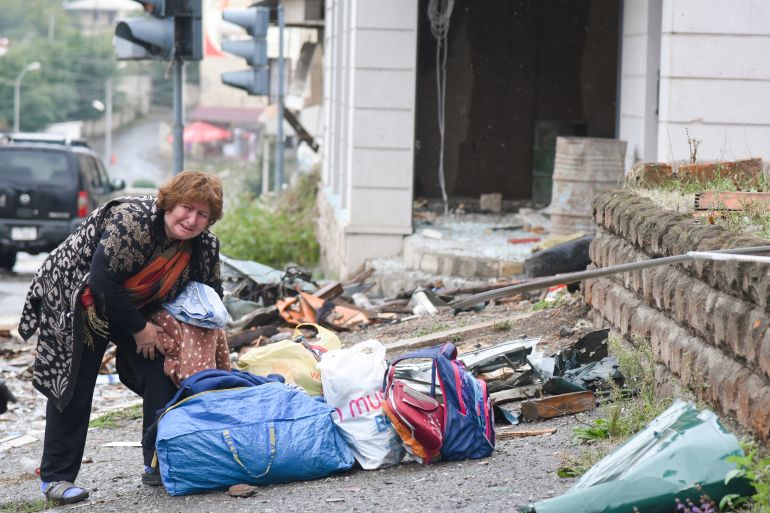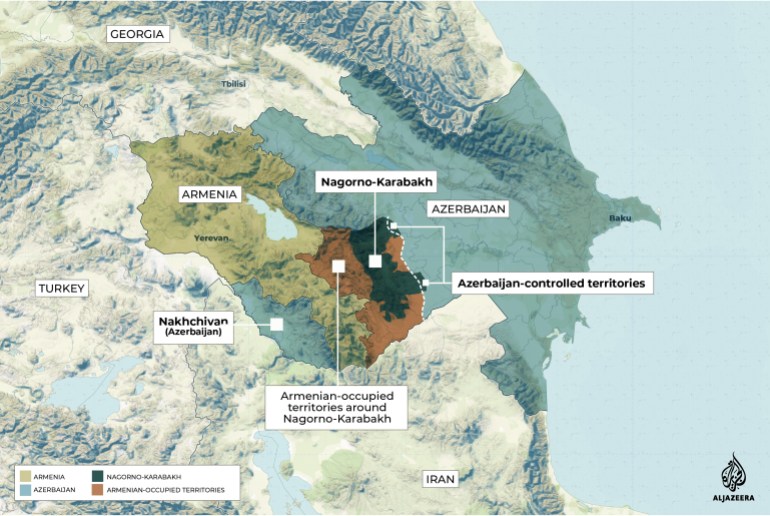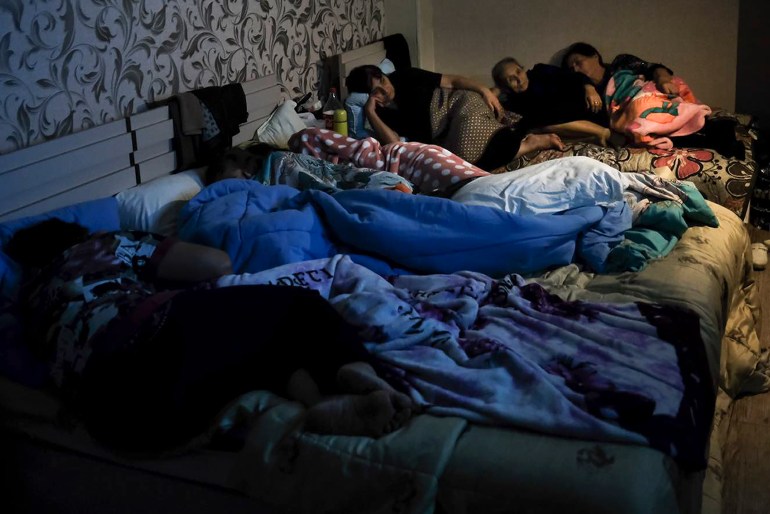Nagorno-Karabakh: Sirens, shelling and shelters in Stepanakert
The main city in the disputed mountain region resembles a ghost town, where people share stories of grief underground.

Stepanakert, Nagorno-Karabakh – An elderly couple walks slowly to one of the city’s few remaining open shops. A car filled with men in fatigues, waving as they pass by, heads towards the eastern edge of the city and the front line. Journalists in front of the Hotel Europe, wearing helmets and ballistic jackets, plan their day.
The wail of air sirens is a regular feature, forcing anyone outside to hurry for cover.
Keep reading
list of 4 itemsThe Take: How Iran’s attack on Israel unfolded
Europe pledges to boost aid to Sudan on unwelcome war anniversary
Accusations of ‘double standards’ at UN after Iran’s attack on Israel
This is a scene in Stepanakert, the main city in Nagorno-Karabakh, or the capital of the unrecognised Republic of Artsakh, as Armenians know it.
Three weeks into the war, it is a ghost town, its population having fled into shelters or further into Armenia.
There are usually about 55,000 people in the city, accounting for roughly a third of Nagorno-Karabakh’s entire population.
Stepanakert is normally bustling and in some ways, it is more modern than cities in Armenia, save Yerevan. An influx of donations by wealthy diaspora Armenians has resulted in roads, clinics and hotels that would not be out of place in a European capital.
Now, the few civilians left here are consigned to underground life in the shelters.
“We came here on the morning of September 27, the first day of the fighting,” says Anyuta, 32. 
A native of Martakert, now a key front-line town in the disputed mountain region, she and her two young children have now spent more than two weeks in the bunker.
Anyuta’s spirits are high, as are her son’s, who smiles and waves.
“We’re doing good here. It’s safe, and we have supplies.”
Like most others, she has family on the front lines.
“My brother stayed behind, he is fighting [in Martakert] now,” she said. Her father is also battling Azerbaijani forces.
“They don’t need him to fight, but he wants to.”
But not everyone is holding together as well.
“My sister’s husband died in the first war [from 1988-1994],” said Nurvard, 69, her voice shaking. “My sister’s son died two days ago. We had his funeral at night. His mother didn’t even see her son’s body.”
Her family has given much to the conflict.
“I have four grandsons fighting on the front right now,” she said. “One of them died three days ago. The others are still there. What do the Turks want with us?”
She breaks into tears and turns away.
Armenia and Azerbaijan renewed their decades-long conflict over Nagorno-Karabakh at the end of September. The region is inside Azerbaijan but run by ethnic Armenians who either want to secede or join Armenia.
The casualties at the front line have been severe.
As of October 15, according to Armenian officials, 604 Armenian and Karabakh soldiers had been confirmed killed.
With a combined population of barely three million, that is the equivalent of the United States losing more than 60,000 men in less than three weeks of fighting.
Azerbaijan does not release details of its military casualties, but it is widely understood the death tolls across the board are higher than what has been officially recorded so far.
Touring Stepanakert, it is clear that the carnage has not been limited to the battlefield.
Most of the city remains intact, but there are pockets of heavy destruction.
In one area, a two metre-deep (6.5 feet) crater straddles the road; in another, the twisted metal of what was once a car stands in front of a blasted house.
The current civilian death toll in Karabakh, according to the latest report released on Sunday by Artak Beglaryan, the territory’s human rights ombudsman, stands at 31.

An additional 106 civilians have been wounded, some reportedly by cluster munitions, an internationally banned weapon.
Amnesty International said on October 5 it had identified “Israeli-made M095 DPICM cluster munitions that appear to have been fired by Azerbaijani forces.”
Azerbaijan has also accused Armenia of using cluster munitions.
The two sides regularly deny the other’s claims regarding attacks.
Missile strikes have not spared critical civilian infrastructure either.
Shelling on Stepanakert’s main power station resulted in a citywide blackout on October 3.
“It’s very visible that Azerbaijan is making an effort to break civilian infrastructure,” Beglaryan told Al Jazeera. “They have hit electricity systems, communications, gas supplies, and others. This can have a large effect as winter approaches.”
Some of these effects are already apparent. While the city’s electricity has been restored, mobile internet is down across Karabakh.
And while the shelling has eased in the past week, it has not stopped.
“This week is much better than last,” said Vazgen, a 65-year old taxi driver whose two sons are on the front lines.
“Last Friday, it was so bad the whole building was shaking.”
He and his friends are unfazed by the sirens. They prefer to spend their time smoking and playing backgammon in the alley outside the shelter.
“If I ran away every time I heard a noise, I wouldn’t have been a very good soldier,” he laughs, recalling his army service in the early 1990s.
But even he has his limits.
“My son is at the front now,” he said. “We won the war, but we couldn’t finish it. We just passed it down to them.”

According to analysts, the destruction of Stepanakert is not likely to be accidental.
When asked if Azerbaijan is intentionally attacking civilian areas, Richard Giragosian, director of the Yerevan-based Regional Studies Center, said: “Of course. I think it’s pretty clear from the cluster bombs, the attack on the church, the indiscriminate fire, that they are.”
Many of the targets hit have no combat value.
“Militarily, it makes no sense,” Giragosian says. “It’s psychological warfare, a sign of desperation. [Azerbaijan is] trying to break the will of the population.”
The International Committee of the Red Cross says that hundreds of buildings have already been destroyed in the conflict.
Stepanakert these days feels like the latest of the ghost towns that populated the no-man’s land between Armenian and Azerbaijani forces.
Its few remaining inhabitants are all that separate the city from being a modern version of Agdam, the city of once 50,000 that has lain abandoned and overgrown at the eastern edge of Karabakh for almost 30 years.
For Lyudmila, a 45-year old cafeteria worker, she hopes this war will be the last.
“This is already the third war I have seen,” she said, referencing the initial conflict and 2016’s so-called Four Day War. “How many more will there be?”
The distant thump of artillery fire echoes behind her words.
